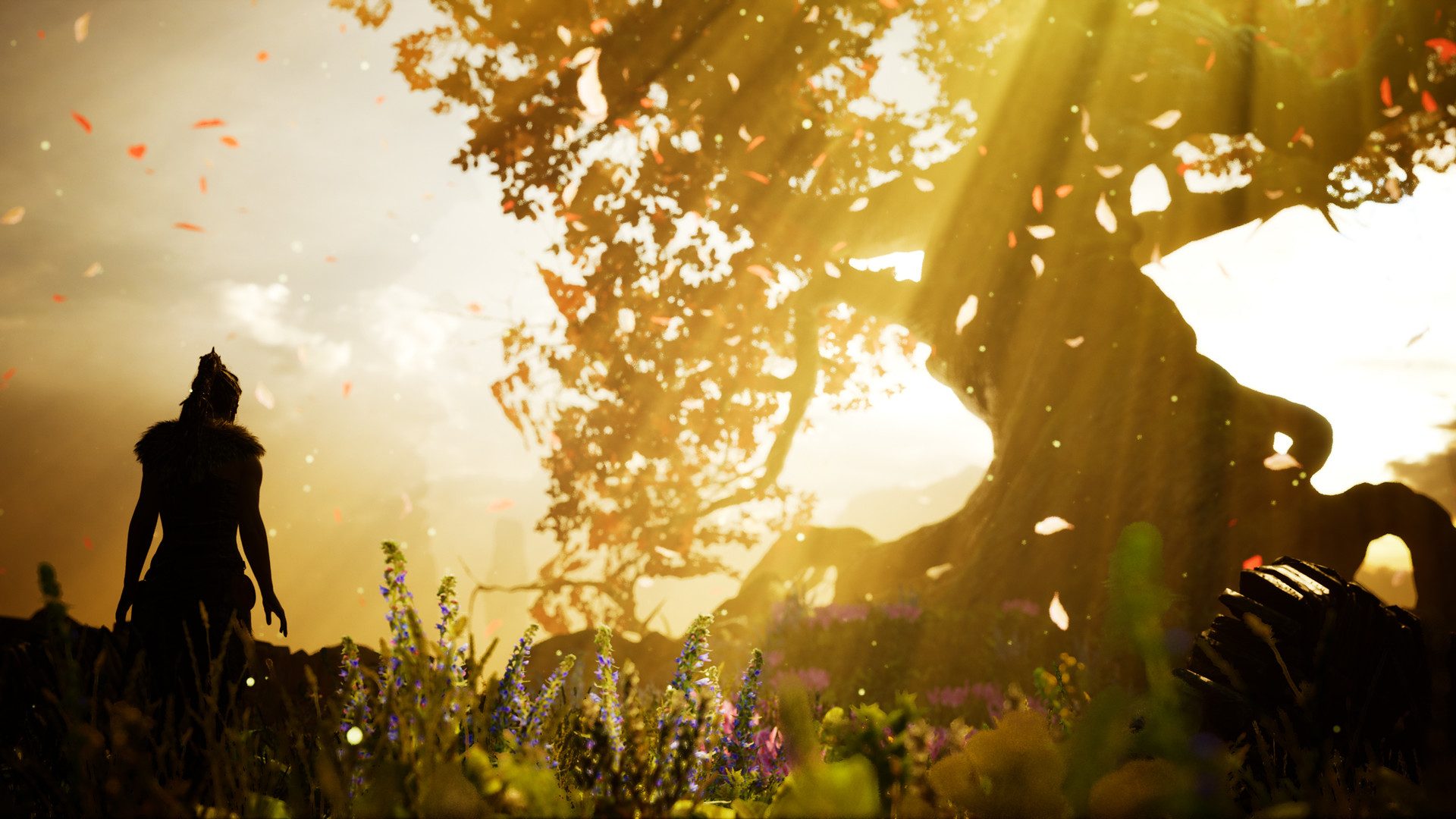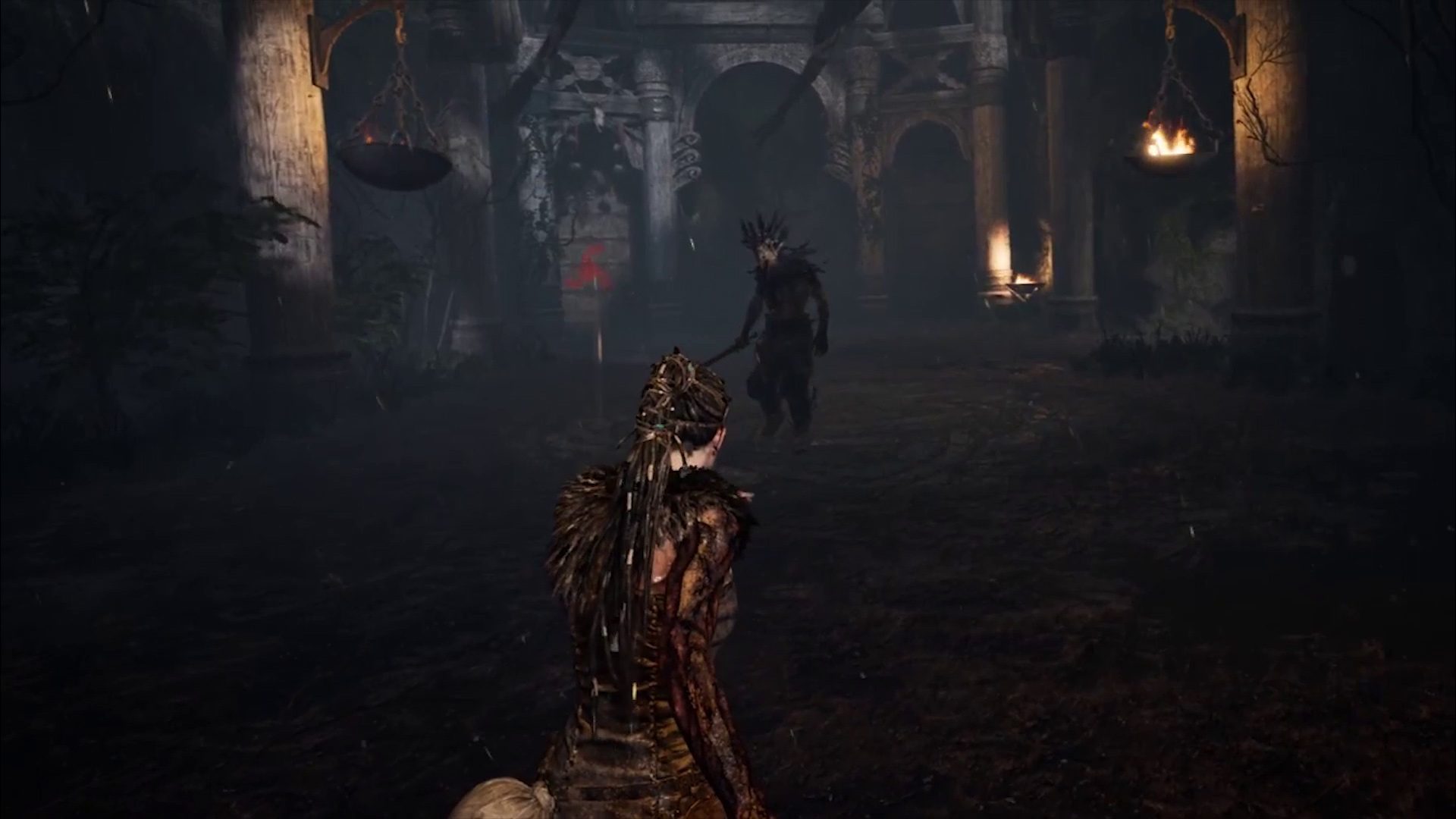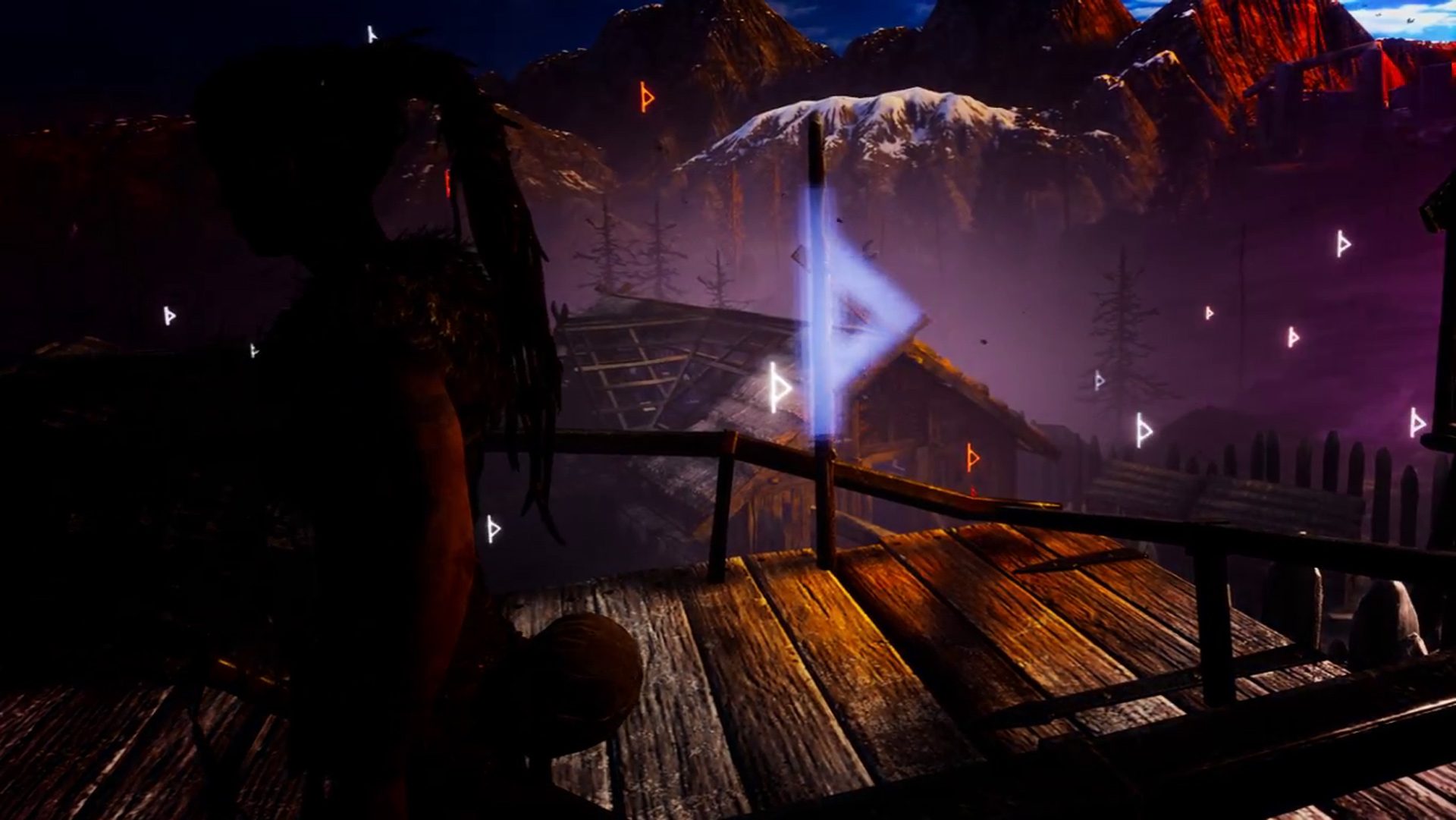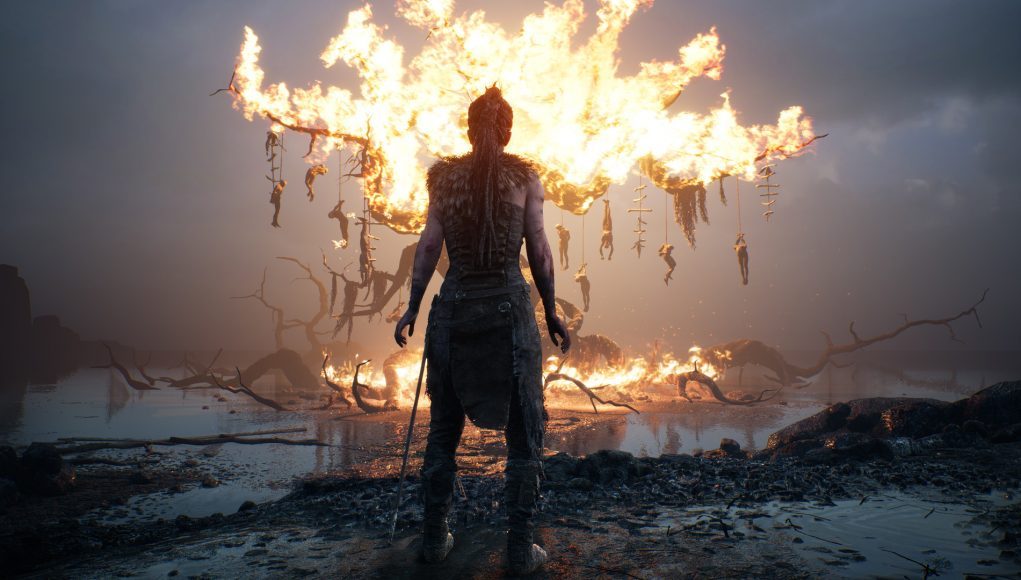Ninja Theory, the minds behind BAFTA award-winning action-adventure game Hellblade: Senua’s Sacrifice (2017), have brought the full, uncut title to Oculus Rift and HTC Vive headsets. We got an exclusive first look at the game’s new VR edition, which is coming free to all owners of the PC game when the update goes live on Steam July 31st. The short of it: it has a few flaws, but it’s a great game.
Update (July 31st, 2018): The VR edition of Hellblade: Senua’s Sacrifice is now available as a free update to the base game. Both Steam and GOG versions of the game are said to arrive with the VR edition.
The original article follows below:
Original Article (July 25th, 2018): If you’ve never played Hellblade: Senua’s Sacrifice, here’s a quick, spoiler-free primer. You can skip these two paragraphs if you’re already well-informed:
Played in the third-person, Senua is a warrior from the Orkney Islands, one of the many spots in the current day United Kingdom that was subject to Viking raids and later colonization throughout the eighth and ninth century. Battling against mythological creatures from both Scandinavian folklore and classic Norse mythology, you push Senua through difficult trials deep into Norse territory, all the while experiencing her pain and reliving her past. Senua suffers from psychosis, and according to the traditions of her people, she was sent to live in the forest alone to battle her own demons. Returning from the wilds, Senua, a fierce warrior, carries the skull of a loved one whose soul was taken hostage by the Norsemen, driving her to battle the gods in a fatalistic and shattered world of her own design.

The game deftly addresses the very serious mental illness of psychosis—a descriptive term that can cover a host of maladies such as hearing voices, seeing hallucinations, and connecting dots that simply aren’t there, like assigning special meaning to everyday occurrences, or by creating elaborate fantasy worlds where the person is entirely immersed in solving cryptic puzzles that surround them in everyday life. This is the basis of the game; the world is constantly shifting, evil spirits confuse and battle you, and internal voices shout you down, casting doubt on your every move. For good reason, the game comes with a trigger warning—something doubly important for the VR version based on just how immersive it can be.
Now for VR
Ever since I started writing about virtual reality four years ago, I’ve found myself playing less and less traditional games, and replacing them almost entirely with VR titles. While I’m slightly ashamed to say I missed out on Hellblade’s PC release last year, my first opportunity to play it was in VR, and outside of a few minor niggles specific to the game’s VR implementation, I’m really glad my first experience with it was from within the immersive viewpoint of a VR headset.

I’ll start with some caveats, but I think you’ll find they’re easily outweighed by the game’s many (many) positives.
On a technical level, Hellblade at minimum requires an Intel i5 3570K or AMD FX-8350, 8 GB RAM, and either a NVIDIA GTX 1080 or AMD Radeon RX 580. Luckily, my testing rig meets those minimum specs, but I don’t suspect the majority of VR owners will. While I imagine lower-speced GPUs might be able to play on lower settings, as I was able to play on the highest possible settings without suffering reprojection with my GTX 1080, Ninja Theory was clear on the game’s minimum requirements for an acceptable experience.
Playing on ‘very high’ for all options—foliage, post-processing, shadows, textures, view distance, and view effects—I did notice at time that textures and some smaller game geometry take a noticeable bit to load in larger areas, which can sometimes detract from what would otherwise be a grand, detailed world. Knocking down to medium settings in some of those departments mitigated this somewhat, but overall the render distance on objects such as plants and rocks (read: far-field scenery loads consistently) appears to be a constant phenomenon, leading to some unsightly texture/geometry popping throughout the game.

The game is in third-person, and there’s no chance of a first-person view coming. This is less of a hindrance than I thought it would be though, as the game can get pretty frightening at moments, what with all the binaurally-captured voices criticizing your every step (these can be turned down) and the ever winding path towards Senua’s declining mental state—it can be equally immersive and frightening, if not more so than many first-person VR games currently.
The last niggle: the only supported controllers are Oculus Touch, gamepads, and keyboard. Vive controllers were likely left out considering the nature of quick inputs needed during fighting sequences; a touchpad simply won’t do. Hopefully Vive users have a spare Xbox One gamepad lying around, because otherwise you’ll be using a standard WASD layout, which isn’t really a great way of playing. Touch controllers are supported, but predictably take the place of a gamepad, as there is no motion controller-specific support.
Caveats Be Damned to Helheim
While these main caveats could stop you from engaging with the game ‘perfectly’, the base experience is anything but disappointing. Hellblade’s engaging narrative quickly takes over, and Senua’s masterful motion capture is delightful to see in VR, as you come face-to-face with the warrior bedecked in blue war paint, who transmits some very realistic and intense emotions. Textures here are dumbed down somewhat for the VR version, but it’s plain to see that the in-your-face view of the character really begins to immerse you in her pain, fears, and struggles through the trials of the game. Check out the gameplay video at the bottom to see what I mean.
Traversing Hellblade, solving its many illusory puzzles, and engaging in combat sequences is a fairly fluid experience. Enemies at times spawn behind you, but the beauty of having a 360 view is in choosing where to look and when, so you can naturally keep an eye on baddies as they come. Combat relies on quick dodges, decisive sword slashes and kicks, and the use of ‘focus’, which activates a slow-mo mode that can both make shadow monsters vulnerable to attack and allow you more time to tear through multiple enemies. Boss battles are, for the lack of a better word, absolutely epic in VR. Should you ever find yourself facing too hard of an adversary though, you can always toggle between easy, medium, hard or ‘auto’ difficulty modes. But watch out; every time you die, an evil rot takes greater hold of your arm, which eventually will lead to your permanent death and a loss of all progress.

Puzzles are especially fun (and rightfully unsettling) in VR, as one of the main features of the game includes the ability for the world to morph around you; a staircase that wasn’t previously there snaps into view after you cross the threshold of a magic gate. The first time it happens, you really begin to question your own sanity, but soon the pieces come together and you start to understand how to use your own illusions to further progress (eg: go through a magic gate to reveal a hole in a wall, go through the hole and unlock the door from the inside). The VR implementation is a natural fit, and I would love to see it in more games.
Another core puzzle throughout Hellbade is lining up runes to open otherwise impenetrable doors—some of the “assigning meaning to things” of Senua’s psychosis—and this is handled really well in VR, as you use your gaze to search and align these runes using your perspective. At moments I would need to crane my neck to get the perfect view, as it’s usually a funny-shaped tree, a few well-placed beams of light, or a piece of a building that has to be lined up, but I tend to think this is based on my preferred game setting. I would routinely enable a higher vantage point in the settings so I could get a better view of the scenery without Senua blocking the way.

The game also has some experimental VR modes too, which can let you view the world either in ‘tiny mode’, which changes your perspective to see the world as a miniature diorama, or ‘giant mode’, which shrinks you down by about by three quarters to make the world decidedly larger than life. I didn’t really faff about with either, as the 1:1 normal mode was exactly how I wanted to play in the first place. In normal mode, scaling on Senua felt slightly larger than reality, but not so far off that she was in any way freakishly large.
Intense Themes, Mostly Comfortable Gameplay
Because the game relies on snap-turning, it’s ultimately pretty comfortable—and that’s despite the game’s forewarning that it’s an ‘intense experience’. There are moments when you smoothly turn into a cinematic mode to face Senua, but these are both conducted slowly and are few and far between, so whatever discomfort you may feel from this artificial locomotion will likely fade in a few seconds. Smooth turning is only available in ‘focus’ mode, which lets you look around for runes and other artifacts.
Since this is originally a PC/console title, the game includes many cutscenes to tell the story, which are refreshingly well handled. Instead of carelessly tossing your POV to fit the narrative, which can cause extreme discomfort, the world zooms out to a black void where you’re given a viewing window to help keep you grounded as things shake up. Had this not been a third-person game, I would say the cutscenes would be an overall a detriment to VR immersion, but somehow the whole narrative of Senua battling herself and her illusions makes this okay. Psychosis can make a person see the world in a different way, and provide out-of-body experiences, so it’s really a fortuitous match-up that I really enjoyed being a part of.
After playing the entire game in VR, which lasted around 7+ hours, I was left sobered and sympathetic to Senua’s plight. She fights for love, but carries her hate with her, something you witness at length throughout the game. I couldn’t help but feel a real connection with her, even though I wasn’t really apart of the story as such. At times she’ll look you in the eye, following the position of your head as you get closer to her. She’s distrustful of you, as you’re sometimes construed as just another illusory companion on her fatalistic journey.
In the end, Ninja Theory may have served up something of a gamepad throwback, which really hasn’t been on the menu since all major PC VR systems now have purpose-built motion control support, but there’s an undeniable charm to the game that will definitely keep you playing. As a high quality offering, Hellblade: Senua’s Sacrifice does enough VR-specific refining to take it out the caste of ‘shoehorned VR ports’; it gives you just enough of the AAA game, which seems to have grasped VR well enough to make it worth your time if you aren’t scared away by the caveats mentioned above. More importantly, it serves as a lesson to other developers that good-looking traditional PC games can, and do work in VR.
Check out a full 14 minute gameplay session below to get a better idea of what Hellblade: Senua’s Sacrifice – VR Edition has to offer.









